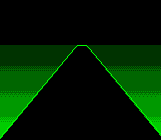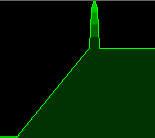WHAT IS A SYNTHESIZER how does it work? (-->this section in german / in deutsch)
goto Sounds / Patches / Demo page..
Sound Synthesis - Dictionary
Tutorials & Tricks Category:List
MIDI Basics - Category:MIDI
SYNTHESIZER INTRODUCTION
Sound Synthesis Types
find out about these here Sound_Synthesis
- SUBTRACTIVE SYNTHESIS
OSCILLATOR (OP, OSC, VCO, DCO)
VCO / Oscillator: controlled by a analogue voltage (normally by keyboard, or other modulators like LFOs etc..) generates Tones with lots of high frequencies (high harmonics!)
DCOs: the same, but digitally controlled: advantage: better stability. this does NOT mean the oscs are completely digitally genereated but controlled!! so a DCO can sound "analogue".
WAVEFORMS and their SPECTRUM
- find audio demos below..
 NOISE WAVEFORM
NOISE WAVEFORM
very rich overtones! means: any frequency/overtone is there..
 SINE WAVE
SINE WAVE
has no more than just one basic tone, no overtones - no chance to filter anything out here!!
 SQUARE WAVE / RECTANGULAR / PULSE
SQUARE WAVE / RECTANGULAR / PULSE
has a rich spectrum but only odd overtones!
this is a symmetric pulsewidth!.. if you CHANGE THE PULSEWIDTH you get more overtones in the spectrum, the sound is "thinner" then.. lots of synthesizers allow to change this pulse width by modulation of an LFO.. make the sound much thicker/fattens up the sound..
 this is also "square wave", but only a short impulse (symmetry of - say 2:98).. by going back to 50:50 there will be some "notches" into the spectrum!!.. see above (square)
this is also "square wave", but only a short impulse (symmetry of - say 2:98).. by going back to 50:50 there will be some "notches" into the spectrum!!.. see above (square)
 SAWTOOTH
SAWTOOTH
has a very rich spectrum including odd and even upper harmonic overtones - some synthesizer like the oberheim matrix 6 or OB-1 allows to seemlessly move the "symmetry" of the sawtooth to triangle wave - this will reduce the overtones as you can see here (so this is some "sort of a LPF" effect (low pass filter):
 TRIANGLE
TRIANGLE
has some more overtones, but not that much..
 ROUNDED SQUARE
ROUNDED SQUARE
not very common, just to show you - the more close you come to sine wave, the less overtones you get..
FILTERS
FILTER VCF: this device can subtract a range of frequencies from the VCO. the most usual are:
LPF - low pass filter - filters out higher frequencies above a certain cutoff frequency with a certain slope (measured in dB or poles): 1 pole are 6dB/Oct.. 2 poles 12dB/Octav, etc..
the usual slope is 24 and 12 dB per Octave. like in the moog minimoog.
HPF - high pass filter - filters out low frequencies below the cutoff.
BPF - band pass filter - this is a combination of LPF and HPF: so it cuts upper and lower frequencies, so whats left is a small "band" in between.
BRF/notch - the opposite of BPF, the band reject filter or so called notch - only filters out a small band, so it is exactly the opposite of a BPF.
APF = all pass filter - well is not a filter but a phase shifting device. all filters will ALSO phase shift the signal!!! so this is for only phaseshifting without filtering: - often used in physical modelling systems.. but rarely used in any kind of other synthesizers..
comb filter / phaser: the comb filter is a special form of filter: it has several notches at a certain distance, that what it make it look like a "comb".
this can be done by a delay with feedback at a quite small delay time as found on the waldorf Q series, Creamware pulsar or korg prophecy and korg z1.
AMPLIFIER
VCA - amplifier - making it louder or attenuate signals by a control voltage
OTHER DEVICES TO CONTROL ABOVE MODULES
LFO - low frequency oscillator - this is the same as an oscillator (VCO or DCO), to create vibrato and the like. vibrato is very simple: connect an LFO to a VCO or DCO to control it's pitch! thats it!
ENVELOPE generator - this is the contour of a sound. if you want to shape a soundi n it's dynamic change (time is the key here!!):
example: hammond organ - when oyu press a key it sounds. when you release it, it immediately stops sounding.
piano with sustain: you press a key and release it: it still sounds..
the most usual form of envelope generator found in synthesizers is ADSR.
key on here ("taste ein" in the picture below)...
A = Attack (rate)
D = Decay (rate)
S = Sustain (level) ---> after that / while that level is being kept: key off. ("taste aus" on the picture)
R = Release (rate)
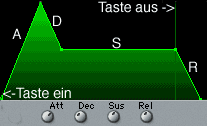
means: press the key, now the sound get louder with ATTACK time to maximum level. after that it goes back to the level set in SUSTAIN with time DECAY. as long as you hold the key, the level will now keeps SUSTAIN level until you release the key. if oyu do that the audio signal will go back to silence with RELEASE time.
got it?
imagine two of them controlling the filter (VCF) and amplifier (VCA)!
so you got dynamical control over the "contour" and "brilliance" of the sound and determin if it is percussive or long sustaining or like a piano or like an organ..
MULTISEGMENT ENVELOPE:
set the time and live for each stage and loop the segments it is the highest level of controlling a sound..
this one is taken from the Waldorf Microwave XT..
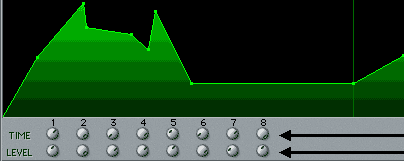
there are also some more interesting things in the OSCILLATOR section:
MORE ABOUT OSCILLATORS
What can be done with 2 Oscillators?
Ringmodulation between 2 Oscilllators: the result is a quite "mtetallic" sound when set to non equal frequencies.. (so better do not only try an interval of 1 octave or any "pure" interval)..what it does? it outputs the sum and difference between the 2 OSCs.. so this is good for "inharmonic and metallic spectra...
simple versions sometimes use XOR technique for rectangular waves!! It produces a waveshape that contains the sum of as well as the difference between the two original waveshapes - XOR mean logically: if any of 2 inputs are true the result is also true but NOT if both signals are true!! (thats the "exlusive"!)..
FM: the FM is easy to understand: one Oscillator modulates another! thats all! but at audio speed, this generates interesting spectra. makes rhodes and bellish sounds very easy!
ppl say it's hard to programme, but it isn't take your dx7 (or something like fmheaven or fm7 software etc..) and lock yourself in a room for 3 days and you got it!!.. the Osc. that controls the frequency of another Osc. is called modulator.
Crossmodulation crossmod: is not "just FM" but modulation of two audio OSCillators (modding each other), a common tech. to create "dirt".. the formula (german: kreuzmodulation a special form of intermodulation) is here
Crossmodulation, Intermodulation:
non linear distortion of one or multiple signals (2 in this case). they start oscillating that do not "belong" to the original oscillation . the difference and the sum. signals
but not really a ringmod but to create dirt and high harmonics. - so it's not just fm.
Crossmodulation is a XOR combination of the square waveshapes of Oscillators 2 and 3:
Crossmodulation - It produces a waveshape that contains the sum of as well as the difference between the two original waveshapes - XOR mean logically: if any of 2 inputs are true the result is also true but NOT if both signals are true!! (thats the "exlusive"!)..
Additive Synthesis
here you don't have filters or osc's with lots of high frequencies. only sine waves. BUT you got lots of oscillators and envelope generators here!
a SINE WAVE is the one that has NO higher frequencies. it's ONLY ONE FREQUENCY. ONE PITCH. no overtones, so you can not filter it! but you can built a sound using a multitude of those simple oscillators and envelope generators EACH!
this gives you a lot of influence as seen on the kawai K5000 series (64 and 128 OSCs!! and more complex env's!)
don't forget: this is the theory, there are lots of frequencies to make a real sound. most synthesizers only got their osc frequencies on the 1st, 2nd, 3rd etc.. harmonics, so to make "inharmonic" sounds it could be of help to tune some oscs to other frequencies in between.. but it's only a question of the hardware/software ;)
physical modeling
models a natural accoustic instrument. the basics are comb filters and delay lines with feedbacks , filters (also all pass filters to only shift the phase) to really model the nature of an accoustic instrument. strings, a tube etc.. it gets interesting if you try to extend the "models" paramters for "unreal" instruments.. the so called VA (virtual analogue) synthesizers also do "model" the old analogue pitch drift and nature of an analogue synthesizer, but this is NOT pm. it's VA ;) just another name ;)
sampling - this uses digitally recorded "samples" (=audio recording) as oscillator. some recent samplers do not only play it faster or slower (micky mouse effect!) but correct the real pitch by techniques like FFT (fast fourier transformation), granular synthesis, resynthesis.. like the vp9000, native instruments "kontakt" etc..
VECTOR SYNTHESIS (prophet vs, wavestation) and WAVETABLE synthesis (waldorf and ppg (micro)wave series)
Vector means: you got 4 OSCs and each of them plays some sample or spectrum..
Now you can "walk" through the 4 OSCs with the stick.. And "record" your "journey"..
That the basic principle.. The WS also can play a "sequence" of samples/waves.. This is sort of having a list that will play any ROM samples you want ..
Wavetables (wavetable synthesis by PPG / Waldorf) are different: you have 60 waves and "walk" through it using an envelope generator with 8 "steps".. So you got lots of control..
You got 2 of those "walkers"..
And you can assign any other mod source to the wavetable that is being "walked" through..
VECTORSYNTHESIS:
like on korg oasys or wavestation or yamaha tg33 / sy 35 22 there are 4 OSCillators that are on the A,b,C or D site of a joystick controller, the envelope to control this movement can be recorded or editied and result in a "crossfading" of 4 very different (or what you like to) sounds, samples or spectrum ..

ADDITIVE SYNTHESIS:
a number of fixed oscillators which have their own envelope are used. they are all sine waves because they need to sound on THEIR specifiy CERTAIN frequency (relative to the basic tone), ANY sound can be re-contructed out of sine waves. they represent the harmonics, but you need 64 like on the kawai k5000 or even more (add 6 of 64 OSCs with ENVelopes in the K5000) you can also detune the OSCs frequencies.. but still this will not allow ANY sound...
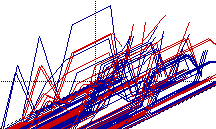
FM-SYNTHESIS (FREQUENCY MODULATION (div. ALGORITHMS):
the idea here is one sine wave oscillator modulated the frequency of another oscillator, mostly called operator because yamaha used this term for the DX , TG and Fs1R series
there are 2 to 8 OP Systems "commonly" offered.. modulars could handle more.. like the G2 or other modular synthesizers..
find a complete "how to make a bass with FM" tutorial here / Tutorial für FM Bass Sounds hier..
how a 6 OP Algorithm setup could be - its how you modulate which oscillator.. a self modded one is called feedback OSC to create noise.. :
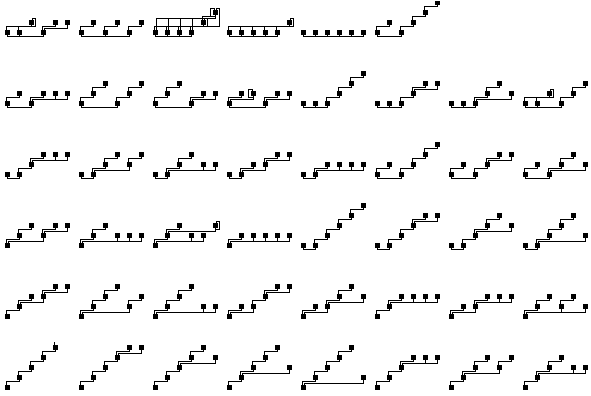
more to come.. questions? please ask in the forum!!
synthesizer magazines:
(remember those made of PAPER?)
also: US mag keyboard (not too deep)..
do you know more? let me know (url?) any language..
there is a cool dutch one.. doon't remember the name?..
some other rescources for browsing..old manuals etc.. goood to learn how synths work!
Synthesizer Basics (BOOK)
http://musiciansource.com/Books/technlgy/bsb.htm
Interesting Shockwave presentation:
http://nmc.uoregon.edu/emi/emp_win/main.html
Some interesting Moog Modular stuff:
http://arts.ucsc.edu/ems/music/equipment/synthesizers/analog/moog/Moog.html
The Beginner's Synthesizer FAQ:
http://www.ezy.net/~genoside/midiwarez/synthfaq.html
http://www.ar.com.au/~novakill/Synth/synth.html
http://home.snafu.de/sicpaul/
http://www.geocities.com/SunsetStrip/Underground/2288/index.htm
http://www.harmony-central.com/Synth/
http://www.helsinki.fi/~ssyreeni/dsound/dsound
http://www.digitalmusicworld.com/html/hardware/SynthSeminars/fm-e/index.html
also: Wizoo books.. wizoo.com
mini glossary / in depth info:
General Synthesizer Information (Synthesizer Basics, Primers, knowledge, etc.)
THE SYNTHESIZER GLOSSARY SYNTH BASICS
eg.: hear how a ringmodulator sound like.., filters? what is a wavetable sound? synth mags: go here
WHAT IS SOFTSYNC ? HOW DOES IT WORK?
I don't know much about how Soft-sync works but it does seem to change tone depending on how the phase of the VCO waveforms are lined up. If I press it on, and off about ten times, you here a different tone at each of the 1 tries. most of them similar, but a few of em will be heavily phase cancelled and tiny. Is this how it works?
BTW
I have a saw on VCO1, and a square wave on VCO2, one octave down
Generally the way synch works when VCO2 is synched to VCO1, is that every time the VCO1 waveform has a positive-going zero crossing (i.e. begins its cycle), the waveform of VCO2 is reset to the beginning of ITS cycle. That's hard synch. With soft synch, the VCO2 waveform does NOT reset for every time VCO1 begins its cycle. It only resets if it is near the end of its cycle, and about to reset anyway.
I'm not sure if that's correct; I believe that any sort of synch relies on the rising edge of the "master" waveform to reset the phase of the "slave". In Soft Synch, the slave oscillator can be caused to completely lock in phase
with the master if their tuning relationships are consonant (octaves, fifths, etc.) It is often neccessary to tune the slave oscillator flat several cents in order to achieve a lock. Check "70's Lead" for a soft-sync'd sound and check the tuning of osc 2. Note that the timbre of a soft-synch'd oscillator changes a bit, even if the master and slave are at the same frequency. In hard sync, the slave becomes a generator of harmonics as it attempts to both freerun and also reset to the rising edge of the master's waveform cycle.
Not all voices will accurately soft sync due to the compromise between the sensitivity requirements of the circuit and the differences in tone which occur. It is an effect which is great for organ sounds (pipe and otherwise) and for firmer bass sounds as well. I've found that if the slave is tuned -below- the master, it will lock a bit better (and IIRC, it's tone is a bit cleaner.
If a slave is exactly twice the frequency of the master, it will produce two complete wavecycles in the exact period of the master's one, with the rising and falling edges being the same for both at the ends. This is useful when creating complex single-cycle waveforms for looping in small memory spaces in ROMplers (means: samples are use that are in the ROM/the fixed memory of the synth). Octloc (sp) in the QS synths was from Emerson's Moog Modular, with three 921bs in soft sync, each an octave higher than the other. I had a sound, Morgan, in a factory set a few revs ago, which was osc 2 soft sync'd to 1 but two octaves higher, both oscillator producing square waves and the suboctaves at equal volume, for a 16-voice stack of four
perfectly-in-phase square waves. There were sounds like this as leads in
the Morg Garson "Moog" records such as Black Mass.
(One of the cooler features of the Wiard VCO is that there's a synch *pot*, which can be adjusted from no synch, through varying degrees of soft synch with the threshold for
>oscillator reset being changed, to rock-solid hard synchronization ... I
>don't know of any others that allow this.)
I was in touch for a short while with a gent who was creating a feature-
packed modular called the EVOS (info in the AH archives). It never saw
the light of day AFAIK but it's oscillators had the same continuously
variable Sync input function.
You have a Wiard? :-)
So with soft synch, if VCO1 & VCO2 at close frequencies, BUT freerunning,whether or not VCO2 will synch to VCO1 may vary based on slight phase/frequency differences between the two oscillators. And as those differences will change over time, yes, the synched sound may vary depending on exactly when you hit the "synch" button.
If you don't have the slave oscillator detuned into the "groove" which allows soft synch to lock, it can jump in and out of synch creating it's own effect. James Reynolds created a sound, "Faux Organ" in the factory presets which takes advantage of this effect, IIRC.
Synths I know of with Soft Sync:
Moog 921b oscillators
Roland SH5 (you have to tune it's slave oscillator flat as well as the A6s)
Matrix 6 (Oberheim)
I know that the curtis 3340 oscillator had a soft sync input pin as well as a hard sync input but I don't remember any CEM synths
with this feature.
Audiodemos for amazona (C)by Moogulator / ConseQuencE
goto digital Synthesizers
analog synthesizer
goto Sounds / Patches / Demos - page..
FORUM - ask everything about synthesizers and more in the forum!..
 NOISE WAVEFORM
NOISE WAVEFORM SINE WAVE
SINE WAVE SQUARE WAVE / RECTANGULAR / PULSE
SQUARE WAVE / RECTANGULAR / PULSE this is also "square wave", but only a short impulse (symmetry of - say 2:98).. by going back to 50:50 there will be some "notches" into the spectrum!!.. see above (square)
this is also "square wave", but only a short impulse (symmetry of - say 2:98).. by going back to 50:50 there will be some "notches" into the spectrum!!.. see above (square) SAWTOOTH
SAWTOOTH TRIANGLE
TRIANGLE ROUNDED SQUARE
ROUNDED SQUARE



